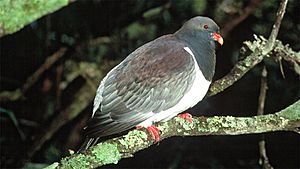Chatham pigeon facts for kids
Quick facts for kids Chatham pigeon |
|
|---|---|
 |
|
| Conservation status | |
| Scientific classification | |
| Genus: |
Hemiphaga
|
| Species: |
chathamensis
|
| Synonyms | |
|
Hemiphaga novaseelandiae chathamensis |
|
The Chatham Island pigeon (Hemiphaga chathamensis), also known as parea (from its Moriori name), is a special bird found only on the Chatham Islands in New Zealand. This means it is endemic to these islands. It's a large pigeon, weighing up to 800 grams and growing to 55 centimeters long. The parea is a close relative of the kererū, which is the New Zealand pigeon. These two are the only types of pigeons in their group, called Hemiphaga.
The parea is listed as a vulnerable species by the IUCN. This means it faces a high risk of becoming extinct in the wild. In New Zealand, it is considered critically threatened. In the late 1980s, there were only about 40 parea left. Thanks to dedicated conservation efforts, their numbers have grown to around 500 birds. Most of these birds live in the southern forests of Chatham Island, especially near the Tuku River. A few parea have also been seen on Pitt Island and South East Island.
Contents
Why the Parea Almost Disappeared
In the 1870s, parea were very common. However, their population dropped sharply to just 40 birds by 1990. This happened for two main reasons:
- Habitat destruction: Their homes, the forests, were cleared.
- Predators: New animals, like cats and rats, were brought to the islands. These animals hunted the parea and their eggs. These are called invasive species.
Since then, people have worked hard to protect the parea. They control predators and put up fences around areas like the Tuku Nature Reserve. These efforts have helped the parea breed more successfully, leading to a rapid increase in their numbers.
Parea vs. Kererū: What's Different?
For a long time, the Chatham Island pigeon was thought to be just a type of kererū. But in 2001, scientists suggested it was different enough to be its own species.
Because the Chatham Islands have been separated from mainland New Zealand for so long, the parea has changed over time. It has evolved differently from its relative, the kererū. Here are some of the differences:
- Size: The Chatham pigeon is about 20% heavier than the kererū.
- Beak: It has a stronger, heavier beak.
- Toes: The parea has a larger back toe. This helps it move around on the forest floor, which is where it often looks for food.
- Nesting time: Chatham pigeons usually nest from June to October. Kererū nest later, from September to January.
- Nesting place: The parea often builds its nest in ferns or bracken close to the ground. The kererū prefers to nest high up in trees.
- Eggs: The Chatham pigeon lays a much bigger egg.
What Parea Eat
Chatham pigeons love to eat fruits from trees like the hoho (Pseudopanax chathamicus), matipo, mahoe, and karamu. They also eat the leaves of mahoe, hoho, and clover. The juicy fruits of the hoho tree are a favorite, especially in August and September. This is also when the pigeons are busiest breeding.
Life of a Parea
Chatham pigeons are known for their amazing flying dives. Males often perform these dives to attract a mate. Most parea start breeding when they are 1 to 2 years old. They usually lay just one egg. The young chicks leave the nest when they are about 45 days old. They become fully independent at around 3 months. Parea can live for a long time, sometimes up to 25 years!
See also
 In Spanish: Paloma de las Chatham para niños
In Spanish: Paloma de las Chatham para niños


